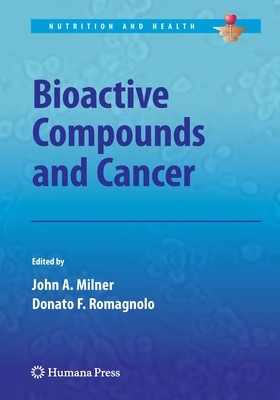
- We will send in 10–14 business days.
- Publisher: Humana
- Year: 2016
- Pages: 829
- ISBN-10: 1493957473
- ISBN-13: 9781493957477
- Format: 17.8 x 25.4 x 4.3 cm, softcover
- Language: English
- SAVE -10% with code: EXTRA
Bioactive Compounds and Cancer (e-book) (used book) | bookbook.eu
Reviews
Description
Chapter 1: Cases Burden Brenda Edwards- NCI Chapter 2: nutrigenomics and cancer biology (are nutrients just nutrients or signaling molecules?) Milner and Romagnolo Chapter 3: cellular cancer Processes Influence By Diet: differentiation, authophagy, Apoptosis, cell division, inflammation, immunity, oxidative stress, angiogenesis (how these processes influence tumor development) Cindy Davis, National Cancer Institute Alternates: David M. Mutch The Scripps Research Institute, Walter Wahli and Gary Williamson University of Lausanne. chapter 4: Nutrigenetics: The Relevance of polymorphisms Christine Ambrosone, Roswell Park Cancer Institute Alternates Nancy Emenaker- NCI chapter 5. diet and epigenetics Richard Waterland, Baylor College of Medicine Alternates Sharon Ross, NCI Chapter 6: Transcriptomics Z.Dong- Hormel Institute Alternates Clement Ip- Roswell Park M. van Erk- Wageningen University part 2: Role of Dietary bioactive components in cancer prevention and/or treatment Section A. macroconstituents chapter 7: dietary Energy and Caloric Restriction Steven D. Hursting, University of Texas chapter 8: fiber and microbially generated active components (fermentable fiber, short chain fatty acids, etc.) Robert Chapkin- Texas A&M Alternates len Augenlicht- Albert Einstein chapter 9: prebiotics and probiotics Glen Gibson- The University of Reading Alternates Marcel Roberfroid University Leon chapter 10: Meats, protein and cancer Sheila Anne Bingham, Medical Research Council, Cambridge, UK. chapter 11: omega-3 fatty acids (are they the good guys) Jose Halperin- Harvard University Alternates Leena Hilakivi-Clarke, Department of Oncology, Georgetown William Lands- NIH chapter 12: omega-6 fatty acids (the bad guys?) W. Elaine Hardman, Louisiana State University chapter 13: saturated fatty acids Michele R. Forman* MD Anderson Chapter 14 Conjugated Linoleic Acid M. Berlury Ohio State Section B. Carotenoinds, Vitamins and Mineral chapter 15: carotenoids (lycopene and beta-carotene) John W. Erdman, Jr., University Illinois chapter 16: vitamin a Catherine Ross Penn State University chapter 17: vitamin d Jim Fleet- Purdue University Alternate Joellen Welsh- Notre Dame Donald l Trump, Roswell Park Cancer Institute chapter 18: Folate: Cornelia Ulrich, Fred Hutchinson Alternate John Baron- Duke University chapter 19: selenium Margaret Rayman- University leeds Alternate Jerry Combs- USDA Grandforks chapter 20: calcium Thomas Rohan- Albert Einstein Alternate Martin Lipkin -Albert Einstein chapter 21: iron James Conner Penn State University chapter 22: zinc L. Fong- Ohio State University Section C. Other Bioactive Food Components chapter 23: isothiocyanates and glucosinolates (ex. sulphoraphane, etc) R.H. Dashwood, Oregon State chapter 24: organosulfur compounds (allium etc.) John Milner- NCI chapter 25: phenols (resveratrol and gingerol) Andreas J. Gescher, University of Leicester alternate A. Dannenberg- Weill Medical College of Cornell University. chapter 26: flavonols, catechins (ex. quercetin and ecgc, etc), and anthocyanins C.S. Yang, Rutgers University Alternate K. Singletary- University of Illinois, 905 chapter 27: isoflavones (genistein etc) Steve Barnes- U. Alabama
EXTRA 10 % discount with code: EXTRA
The promotion ends in 18d.11:24:49
The discount code is valid when purchasing from 10 €. Discounts do not stack.
- Publisher: Humana
- Year: 2016
- Pages: 829
- ISBN-10: 1493957473
- ISBN-13: 9781493957477
- Format: 17.8 x 25.4 x 4.3 cm, softcover
- Language: English English
Chapter 1: Cases Burden Brenda Edwards- NCI Chapter 2: nutrigenomics and cancer biology (are nutrients just nutrients or signaling molecules?) Milner and Romagnolo Chapter 3: cellular cancer Processes Influence By Diet: differentiation, authophagy, Apoptosis, cell division, inflammation, immunity, oxidative stress, angiogenesis (how these processes influence tumor development) Cindy Davis, National Cancer Institute Alternates: David M. Mutch The Scripps Research Institute, Walter Wahli and Gary Williamson University of Lausanne. chapter 4: Nutrigenetics: The Relevance of polymorphisms Christine Ambrosone, Roswell Park Cancer Institute Alternates Nancy Emenaker- NCI chapter 5. diet and epigenetics Richard Waterland, Baylor College of Medicine Alternates Sharon Ross, NCI Chapter 6: Transcriptomics Z.Dong- Hormel Institute Alternates Clement Ip- Roswell Park M. van Erk- Wageningen University part 2: Role of Dietary bioactive components in cancer prevention and/or treatment Section A. macroconstituents chapter 7: dietary Energy and Caloric Restriction Steven D. Hursting, University of Texas chapter 8: fiber and microbially generated active components (fermentable fiber, short chain fatty acids, etc.) Robert Chapkin- Texas A&M Alternates len Augenlicht- Albert Einstein chapter 9: prebiotics and probiotics Glen Gibson- The University of Reading Alternates Marcel Roberfroid University Leon chapter 10: Meats, protein and cancer Sheila Anne Bingham, Medical Research Council, Cambridge, UK. chapter 11: omega-3 fatty acids (are they the good guys) Jose Halperin- Harvard University Alternates Leena Hilakivi-Clarke, Department of Oncology, Georgetown William Lands- NIH chapter 12: omega-6 fatty acids (the bad guys?) W. Elaine Hardman, Louisiana State University chapter 13: saturated fatty acids Michele R. Forman* MD Anderson Chapter 14 Conjugated Linoleic Acid M. Berlury Ohio State Section B. Carotenoinds, Vitamins and Mineral chapter 15: carotenoids (lycopene and beta-carotene) John W. Erdman, Jr., University Illinois chapter 16: vitamin a Catherine Ross Penn State University chapter 17: vitamin d Jim Fleet- Purdue University Alternate Joellen Welsh- Notre Dame Donald l Trump, Roswell Park Cancer Institute chapter 18: Folate: Cornelia Ulrich, Fred Hutchinson Alternate John Baron- Duke University chapter 19: selenium Margaret Rayman- University leeds Alternate Jerry Combs- USDA Grandforks chapter 20: calcium Thomas Rohan- Albert Einstein Alternate Martin Lipkin -Albert Einstein chapter 21: iron James Conner Penn State University chapter 22: zinc L. Fong- Ohio State University Section C. Other Bioactive Food Components chapter 23: isothiocyanates and glucosinolates (ex. sulphoraphane, etc) R.H. Dashwood, Oregon State chapter 24: organosulfur compounds (allium etc.) John Milner- NCI chapter 25: phenols (resveratrol and gingerol) Andreas J. Gescher, University of Leicester alternate A. Dannenberg- Weill Medical College of Cornell University. chapter 26: flavonols, catechins (ex. quercetin and ecgc, etc), and anthocyanins C.S. Yang, Rutgers University Alternate K. Singletary- University of Illinois, 905 chapter 27: isoflavones (genistein etc) Steve Barnes- U. Alabama


Reviews